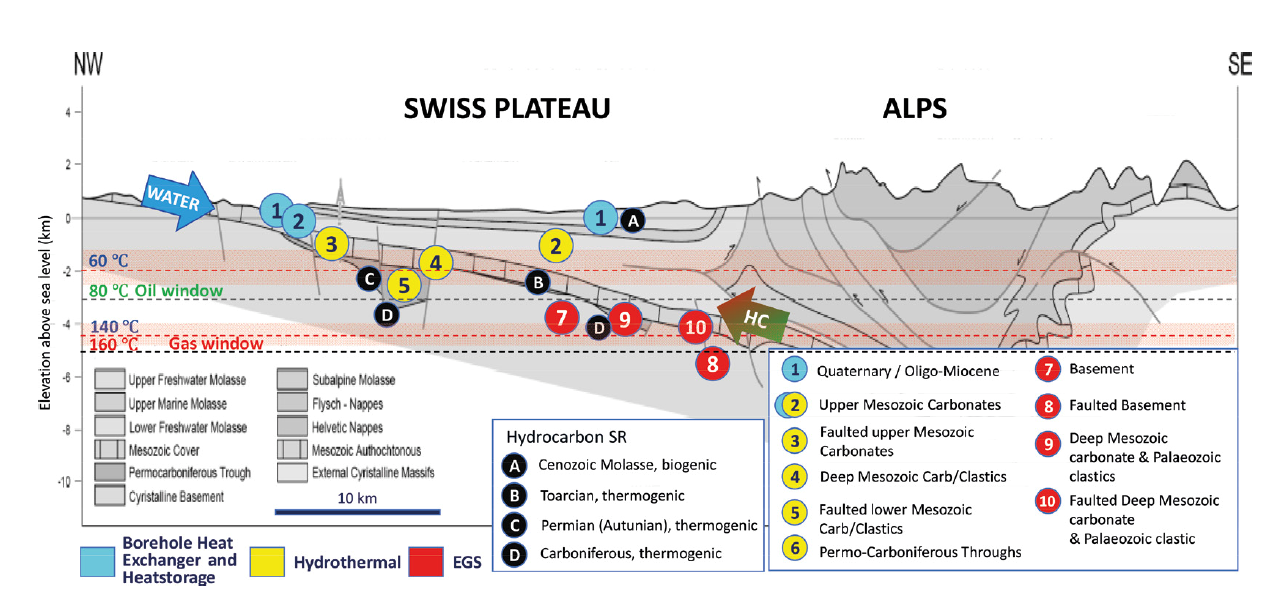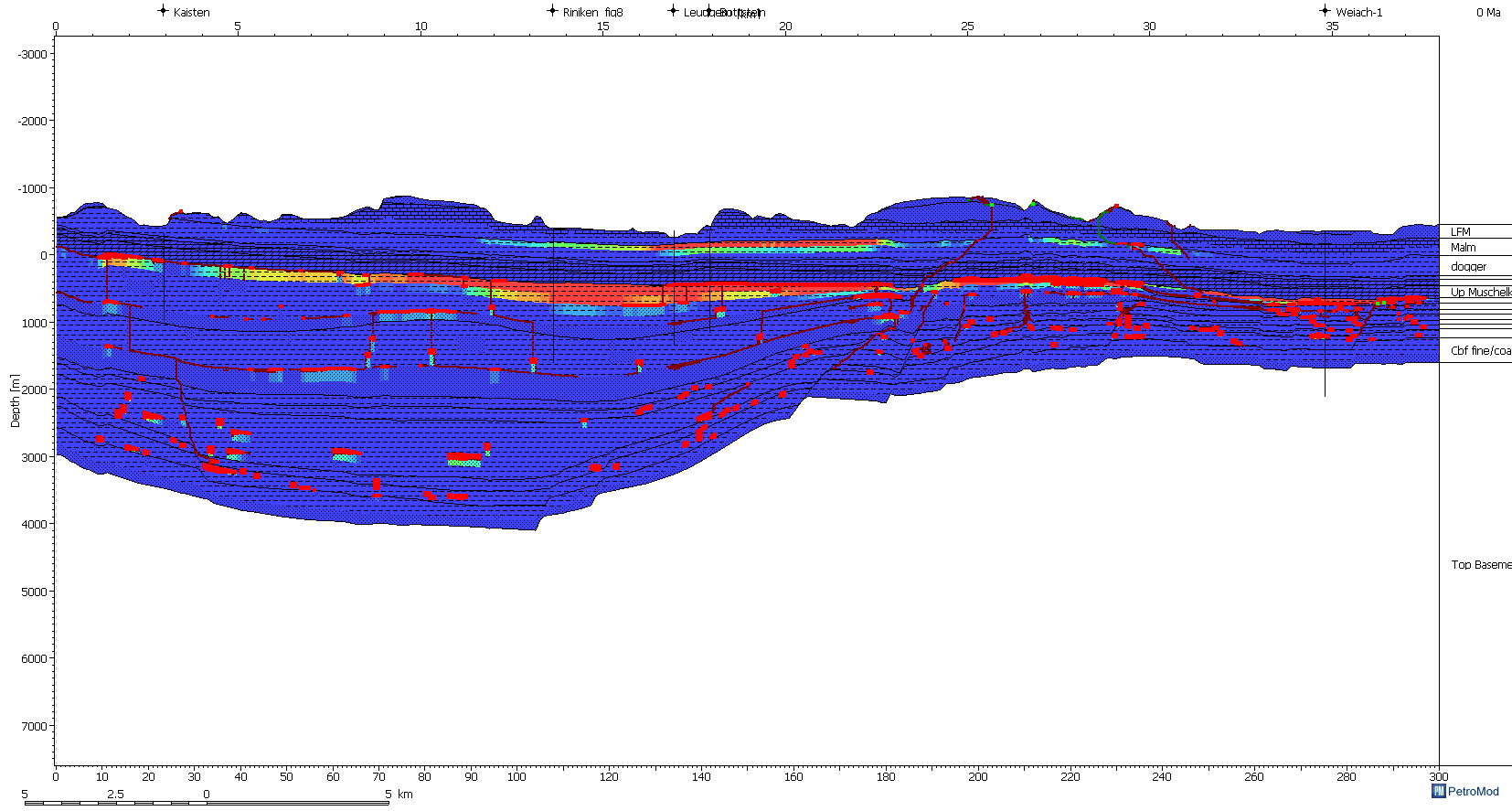The prediction of hydrocarbons occurrence in the Swiss Plateau reduces the risks for Geothermal exploration
One of the challenges that deep geothermal exploration faces is the occurrence of accumulations of hydrocarbons (such as natural gas or raw oil) in the subsurface. Is this a concern for Switzerland? Are there accumulations of hydrocarbons that might encumber the development of Swiss geothermal energy? Could these two geo-resources share the same reservoirs and/or flowpaths and how might the development of geothermal energy resources be influenced and affected by it? The UNCONGEO project seeks to answer all those questions.
The UNCONGEO project aims at predicting and quantifying the risks for the geothermal exploration activity in Switzerland associated with the presence of natural gas and oil in the subsurface. UNCONGEO - supported by the Federal Office of Energy (SFOE), the Swiss Geological Survey (Swisstopo), NAGRA and few cantons (Canton of Geneva and Canton of Vaud) - contributes substantially to the topics addressed by the SCCER-SoE associated with the challenges of deep geothermal exploration in sedimentary basins. To achieve this goal, we – a group of scientists from the University of Geneva - have applied an industry-standard petroleum system modelling approach, which integrates multidisciplinary and multiscale subsurface data using thermal modelling.
In the first phase (2017-2019), the UNCONGEO activities focused on the reconstruction of the thermal history of the Swiss Foreland Basin and to relate it with the generation, migration and accumulation of hydrocarbons. The investigation included several areas: the St. Gallen area, the Canton of Vaud, the North-eastern Switzerland area and the Canton of Geneva. The workflow comprises the reconstruction of a geological model, based on seismic and well data, the petrographic and geochemical characterization of the main petroleum system elements (source rocks, reservoirs and seals) and the definition of the potential stratigraphic and structural traps. These outcomes permit to reconstruct risk maps, which show the probability to find hydrocarbons in the subsurface in a given area.
The work carried out by this project improves the understanding of the tectonic, geodynamic and stratigraphic variables controlling the formation and distribution of hydrocarbons reserves in the Swiss Foreland Basin. We also identified the main uncertainties on the petroleum system modelling results. The project’s future activities will focus on reducing these uncertainties and on better quantifying the risk associated with the presence of hydrocarbons in specific areas of interest.

Summary of geothermal and hydrocarbon plays on an ideal section across the Swiss Plateau. The circles with numbers indicate the different geothermal plays and the type of geothermal energy utilization (borehole heat exchange, heat-storage, hydrothermal and enhanced/engineered geothermal systems). The arrows indicate the main direction of water circulation in the subsurface which is primarily opposite to the up-dip migration of hydrocarbons (Moscariello, 2019).
The St. Gallen study case
The most illustrative example of the workflow adopted by the UNCONGEO project is the St. Gallen study case. The St. Gallen deep geothermal well was initially designed as part of a hydrothermal doublet in the year 2011-2012 and drilled throughout the year 2013. The main goal of the well was to introduce geothermal energy as a main heat source for the existing local district heating network and possibly also for electricity production. During the drilling operation, at a depth of 4450 meters below ground level, natural gas started to enter into the borehole, producing a gas kick. To control the sudden increase of gas inflow, heavy drill mud, freshwater and lost-circulation materials were pumped into the well. This operation triggered microseismicity around the area mainly below target depth. A series of earthquakes were induced culminating with a ML 3.5, widely felt by the population in Northeastern Switzerland (intensity IV on the European Macroseismic Scale EMS-98). Geochemical analyses of this gas indicate a thermogenic origin, thus from deep mature source rocks.
In the context of the UNCONGEO project, we defined the main elements and processes occurring in the petroleum system in the St. Gallen area which led us at estimating the hydrocarbon potential (amount of gas generated, potential reservoirs, the volume of hydrocarbons accumulated, etc…) of the area around the well. We reconstructed a 3D thermal model based on the interpretation and depth-conversion of the 3D seismic survey data to achieve these objectives. The source rocks that are located most likely in the deeply seated Permo-Carboniferous grabens and composed of coal and carbonaceous shales, are at present generating gas. The volume of the hydrocarbons generated is related to the thickness of the source rocks assigned to the model, which we extrapolated from offset well data. Only a minimal proportion of the hydrocarbons generated were accumulated in reservoirs, mostly located in the Permo-Carboniferous sandstones and the lowermost Mesozoic units. Our results indicate that the volume calculated for these accumulations mostly depends on the accuracy of the distribution and size of the stratigraphic and structural trap. Further researches will aim at constraining the uncertainties controlling the volume of hydrocarbon generated and accumulated in the area and offer a reliable assessment of geo-energy potential hidden in the St. Gallen subsurface.

Thermal modelling of a 2D geological cross-section in the northern sector of Switzerland WNW-ESE oriented (82-NS-70), where the petroleum saturated zones (red, orange, yellow and green colors) and the location of potential hydrocarbons reservoirs (full red zones) are simulated.
Conclusion and outlook
In this work we demonstrated that, by applying a thermal modelling workflow, gas accumulations can be predicted, as demonstrated in the case of the St. Gallen area. The UNCONGEO project will carry out further research on the entire Swiss Plateau, to individuate the areas where hydrocarbons can be found in the subsurface, thus representing a risk for the geothermal energy exploration.
